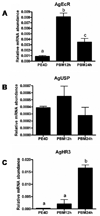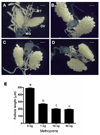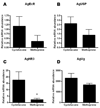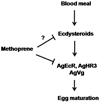Mode of action of methoprene in affecting female reproduction in the African malaria mosquito, Anopheles gambiae
- PMID: 20730984
- PMCID: PMC2928151
- DOI: 10.1002/ps.1962
Mode of action of methoprene in affecting female reproduction in the African malaria mosquito, Anopheles gambiae
Abstract
Background: One of the most studied actions of juvenile hormone (JH) is its ability to modulate ecdysteroid signaling during insect development and metamorphosis. Previous studies in mosquitoes showed that 20-hydroxyecdysone (20E) regulates vitellogenin synthesis. However, the action of JH and its mimics, e.g. methoprene, on female reproduction of mosquitoes remains unknown.
Results: Here, a major malaria vector, Anopheles gambiae Giles, was used as a model insect to study the action of methoprene on female reproduction. Ecdysteroid titers and expression profiles of ecdysone-regulated genes were determined before and after a blood meal. An ecdysteroid peak was detected at 12 h post blood meal (PBM). The maximum expression of ecdysone-regulated genes, such as ecdysone receptor (EcR), hormone receptor 3 (HR3) and vitellogenin (Vg) gene, coincided with the ecdysteroid peak. Interestingly, topical application of methoprene at 6 h PBM delayed ovarian development and egg maturation by suppressing the expression of ecdysone-regulated genes in female mosquitoes.
Conclusion: The data suggest that ecdysteroid titers are correlated with Vg synthesis, and methoprene affects vitellogenesis by modulating ecdysteroid action in A. gambiae.
(c) 2010 Society of Chemical Industry.
Figures






References
-
- Raikhel AS, Kokoza VA, Zhu J, Martin D, Wang SF, Li C, Sun G, Ahmed A, Dittmer N, Attardo G. Molecular biology of mosquito vitellogenesis: from basic studies to genetic engineering of antipathogen immunity. Insect Biochem Mol Biol. 2002;32:1275–1286. - PubMed
-
- Dhadialla TS, Raikhel AS. Perspectives in Comparative Endocrinology. Canada: National Research Council of Canada; 1994. Endocrinology of mosquito vitellogenesis; pp. 275–281.
-
- Cho WL, Kapitskaya MZ, Raikhel AS. Mosquito ecdysteroid receptor: analysis of the cDNA and expression during vitellogenesis. Insect Biochem Mol Biol. 1995;25:19–27. - PubMed
-
- Kapitskaya M, Wang S, Cress DE, Dhadialla TS, Raikhel AS. The mosquito ultraspiracle homologue, a partner of ecdysteroid receptor heterodimer: cloning and characterization of isoforms expressed during vitellogenesis. Mol Cell Endocrinol. 1996;121:119–132. - PubMed
-
- Wang SF, Li C, Zhu J, Miura K, Miksicek RJ, Raikhel AS. Differential expression and regulation by 20-hydroxyecdysone of mosquito ultraspiracle isoforms. Dev Biol. 2000;218:99–113. - PubMed
Publication types
MeSH terms
Substances
Grants and funding
LinkOut - more resources
Full Text Sources
Medical

